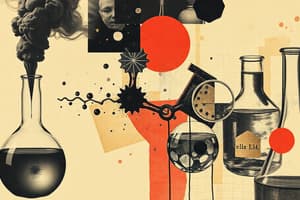Podcast
Questions and Answers
Which metal burns with a lilac flame when heated in the air?
Which metal burns with a lilac flame when heated in the air?
- Potassium (correct)
- Magnesium
- Calcium
- Sodium
What is the color of the flame observed when magnesium is heated in the air?
What is the color of the flame observed when magnesium is heated in the air?
- Brilliant white (correct)
- Golden yellow
- Brick red
- White
What is the product formed when iron is heated strongly in the air?
What is the product formed when iron is heated strongly in the air?
- Zinc oxide
- Lead oxide
- Iron oxide (correct)
- Copper oxide
What is the observation when lead is heated strongly in the air?
What is the observation when lead is heated strongly in the air?
Which metal reacts with oxygen to form a white powder when heated gently in the air?
Which metal reacts with oxygen to form a white powder when heated gently in the air?
What is the product formed when copper is heated strongly in the air?
What is the product formed when copper is heated strongly in the air?
Which of the following is an example of a displacement reaction?
Which of the following is an example of a displacement reaction?
Which of the following metals is most likely to displace copper from a copper sulfate solution?
Which of the following metals is most likely to displace copper from a copper sulfate solution?
What is the nature of aluminum oxide?
What is the nature of aluminum oxide?
Which of the following metals is least reactive, according to the reactivity series?
Which of the following metals is least reactive, according to the reactivity series?
What is the oxidation state of iron in a reaction where it forms a compound with oxygen?
What is the oxidation state of iron in a reaction where it forms a compound with oxygen?
Which metal can displace copper from a copper(II) sulfate solution according to the reactivity series?
Which metal can displace copper from a copper(II) sulfate solution according to the reactivity series?
What is the oxidation state of sodium in a reaction where it forms a compound with chlorine?
What is the oxidation state of sodium in a reaction where it forms a compound with chlorine?
What is the outcome of a metal displacement reaction involving a more reactive metal and a less reactive metal?
What is the outcome of a metal displacement reaction involving a more reactive metal and a less reactive metal?
What happens when calcium is added to water?
What happens when calcium is added to water?
What is the product of the reaction between steam and zinc?
What is the product of the reaction between steam and zinc?
What is the observation when potassium is added to water?
What is the observation when potassium is added to water?
What is the product of the reaction between steam and iron?
What is the product of the reaction between steam and iron?
What happens when sodium is added to cold water?
What happens when sodium is added to cold water?
What is the product of the reaction between steam and magnesium?
What is the product of the reaction between steam and magnesium?
What happens when very reactive metals like potassium react with dilute acids?
What happens when very reactive metals like potassium react with dilute acids?
What is the reason for the lack of observable change when aluminium reacts with dilute acids at first?
What is the reason for the lack of observable change when aluminium reacts with dilute acids at first?
What happens when the oxide layer on the surface of aluminium is completely reacted with the dilute acid?
What happens when the oxide layer on the surface of aluminium is completely reacted with the dilute acid?
Which of the following metals do not react with dilute acids?
Which of the following metals do not react with dilute acids?
What is the product formed when aluminium oxide reacts with hydrochloric acid?
What is the product formed when aluminium oxide reacts with hydrochloric acid?
What is the characteristic of the reaction between aluminium and dilute acids?
What is the characteristic of the reaction between aluminium and dilute acids?
What is the purpose of heating the metal in the set-up?
What is the purpose of heating the metal in the set-up?
What happens when calcium is added to water?
What happens when calcium is added to water?
What is the product of the reaction between steam and zinc?
What is the product of the reaction between steam and zinc?
Why should the mineral wool not be heated?
Why should the mineral wool not be heated?
What is the product of the reaction between steam and iron?
What is the product of the reaction between steam and iron?
What is the observation when potassium is added to water?
What is the observation when potassium is added to water?
Flashcards
Potassium flame color
Potassium flame color
Potassium produces a lilac flame when heated in air.
Magnesium flame color
Magnesium flame color
Magnesium burns with a brilliant white flame.
Iron heated in air
Iron heated in air
Iron forms iron oxide (rust) when heated strongly in air.
Lead heated in air
Lead heated in air
Signup and view all the flashcards
Sodium heated in air
Sodium heated in air
Signup and view all the flashcards
Copper heated in air
Copper heated in air
Signup and view all the flashcards
Displacement reaction example
Displacement reaction example
Signup and view all the flashcards
Metal displacing copper
Metal displacing copper
Signup and view all the flashcards
Aluminum oxide nature
Aluminum oxide nature
Signup and view all the flashcards
Least reactive metal
Least reactive metal
Signup and view all the flashcards
Iron oxidation state
Iron oxidation state
Signup and view all the flashcards
Metal displacing copper(II)sulfate
Metal displacing copper(II)sulfate
Signup and view all the flashcards
Sodium oxidation state
Sodium oxidation state
Signup and view all the flashcards
Metal displacement reaction outcome
Metal displacement reaction outcome
Signup and view all the flashcards
Calcium reaction with water
Calcium reaction with water
Signup and view all the flashcards
Steam and zinc product
Steam and zinc product
Signup and view all the flashcards
Potassium reaction with water
Potassium reaction with water
Signup and view all the flashcards
Steam and iron product
Steam and iron product
Signup and view all the flashcards
Sodium reaction with cold water
Sodium reaction with cold water
Signup and view all the flashcards
Steam and magnesium product
Steam and magnesium product
Signup and view all the flashcards
Reactive metals and dilute acids
Reactive metals and dilute acids
Signup and view all the flashcards
Aluminium reaction with dilute acids (initial)
Aluminium reaction with dilute acids (initial)
Signup and view all the flashcards
Aluminium oxide layer reaction
Aluminium oxide layer reaction
Signup and view all the flashcards
Metals unreactive with dilute acids
Metals unreactive with dilute acids
Signup and view all the flashcards
Aluminum oxide and hydrochloric acid reaction
Aluminum oxide and hydrochloric acid reaction
Signup and view all the flashcards
Aluminum and dilute acids reaction
Aluminum and dilute acids reaction
Signup and view all the flashcards
Purpose of heating metal
Purpose of heating metal
Signup and view all the flashcards
Study Notes
Reactivity Series
- A list of metals in order of their reactivity, with the most reactive at the top and the least reactive at the bottom
- The series is based on the metal's ability to lose electrons and form ions
- The reactivity series consists of, in order: potassium (K), sodium (Na), calcium (Ca), magnesium (Mg), aluminium (Al), zinc (Zn), iron (Fe), tin (Sn), lead (Pb), copper (Cu), silver (Ag), and gold (Au)
Oxidation States
- The oxidation state of an element is the number of electrons it has lost or gained to form a bond
- Metals tend to lose electrons to form a positive ion (cation) and have a positive oxidation state
- The oxidation state of a metal can vary depending on the reaction it is involved in
- Examples of oxidation states include:
- Sodium (Na) typically having an oxidation state of +1
- Iron (Fe) having oxidation states of +2 or +3
- Copper (Cu) having oxidation states of +1 or +2
Metal Displacement
- A reaction in which a more reactive metal displaces a less reactive metal from its compound
- The more reactive metal loses electrons and becomes an ion, while the less reactive metal gains electrons and becomes a neutral atom
- The reactivity series can be used to predict the outcome of metal displacement reactions
- Examples of metal displacement reactions include:
- Zinc (Zn) displacing copper (Cu) from copper(II) sulfate solution
- Iron (Fe) not displacing copper (Cu) from copper(II) sulfate solution because iron is less reactive than copper
Studying That Suits You
Use AI to generate personalized quizzes and flashcards to suit your learning preferences.




